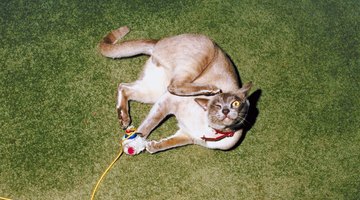Myrtle Bushes for Flea Control
The southern waxmyrtle bush (Myrica cerifera) is used to repel fleas. The plant is a small multi-stemmed shrub native to southern coastal forests and wetlands in the U.S. Myrtle bushes are also known as bayberry, candleberry and tallow shrub.

Early American settlers used the wax extracted from the tree’s berries to make candles. Crushed leaves rubbed on the skin repel mosquitoes, and myrtle bush boughs are used to repel fleas.
Plant Description
Waxmyrtle bushes are evergreen perennials and grow to a mature height of 15 to 20 feet. The leaves are long and pointed, growing in clusters at the ends of branches. The leaves grow for two seasons before dropping. Small white flowers bloom in the spring and develop into berries by autumn. The female of the species produces small, round grayish-blue berries that encircle the stem.
Flea Repellent
The chemical compounds in myrtle bush leaves and branches that repel fleas include flavonoids, tannins, resins, gums and phenols. Myricitrin is a chemical compound found in waxmyrtle trees. It is used in the treatment of fever and intestinal problems.The plant is used in traditional medicine as a treatment for fever and dysentery. According to the University of North Carolina, residents in coastal areas put waxmyrtle branches under their beds to discourage fleas and insects.
Flea Behavior
The life cycle of a flea is about a month, depending on temperature and humidity. Adult female fleas lay 30 to 50 eggs per day on a host animal. The eggs do not attach to the animal. They fall off where the animal sleeps or moves through the house. Fleas in the larval stage hatch, grow and wait for a host animal to begin feeding. They feed on blood to complete their life cycle and reproduce.
Integrated Pest Management Strategies
An increase in the amount of flea infestations has caused entomologists and pest control professionals to speculate that fleas have developed resistance to pesticides that contain imidacloprid and fipronil. Experts recommend taking the least toxic approach first to eradicate harmful pests. Cultural methods, such as vacuuming and frequent laundering of bedding, may help prevent infestations. Aromatic plants, such as myrtle bush, pennyroyal and fleabane, are traditional remedies for flea infestations. Neem oil is also effective in flea control.
The Drip Cap
- The southern waxmyrtle bush (Myrica cerifera) is used to repel fleas.
- The plant is a small multi-stemmed shrub native to southern coastal forests and wetlands in the U.S.
- Myrtle bushes are also known as bayberry, candleberry and tallow shrub.
- The leaves are long and pointed, growing in clusters at the ends of branches.
- The plant is used in traditional medicine as a treatment for fever and dysentery.
- According to the University of North Carolina, residents in coastal areas put waxmyrtle branches under their beds to discourage fleas and insects.
- Fleas in the larval stage hatch, grow and wait for a host animal to begin feeding.
References
Writer Bio
Joan Norton, M.A., is a licensed psychotherapist and professional writer in the field of women's spirituality. She blogs and has two published books on the subject of Mary Magdalene: "14 Steps To Awaken The Sacred Feminine: Women in the Circle of Mary Magdalene" and "The Mary Magdalene Within."
Photo Credits
- Jupiterimages/Photos.com/Getty Images
- Jupiterimages/Photos.com/Getty Images
More Articles



